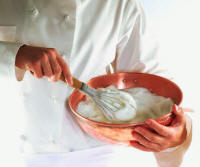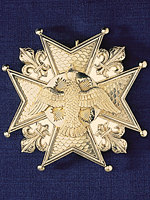History of Cordon Bleu Cuisine
4th April is Cordon Bleu Day
Jump to:- What
is Cordon Bleu Cuisine ? |
How did Cordon Bleu get its name?
|
About Le Cordon Bleu

Photo � athinaanto - Fotolia.com
Go to:
Main History
Index Page
|
History of World Cuisines
Traditionally, Cordon Bleu cuisine is the term given
to dishes using classic French cooking techniques
and preparations,
covering everything from sauces to patisserie. To
many, the term has become synonymous with Nouvelle
Cuisine which characteristically produces lighter, more
delicate dishes with an emphasis on presentation. However, this isn't strictly correct as many classic
French cooking techniques are founded in the
Haute Cuisine style which is richer with
more elaborate techniques and Cuisine Classique
which, whilst still relatively rich, is generally less convoluted than Haut
Cuisine.
Techniques in the Cordon Bleu repertoire are wide
and cover everything from ingredient selection and
preparation to complete recipes. Many of which
techniques have barely changed from the originals,
but the beauty lies in the fact that once
understood and mastered, can be applied to any
cuisine and adapted for modern day eating.
 The term Cordon Bleu translated into English means "Blue Ribbon" and has been synonymous with culinary excellence since the
16th century. King Henry III created one of the most important orders in
France, �L�Ordre du Saint-Esprit� which was symbolised by the cross of the
Holy Spirit hanging on a blue ribbon or un cordon bleu. The award
ceremonies were often accompanied by lavish feasts and in time, the name Le Cordon Bleu became
closely associated with gastronomic excellence. The term Cordon Bleu translated into English means "Blue Ribbon" and has been synonymous with culinary excellence since the
16th century. King Henry III created one of the most important orders in
France, �L�Ordre du Saint-Esprit� which was symbolised by the cross of the
Holy Spirit hanging on a blue ribbon or un cordon bleu. The award
ceremonies were often accompanied by lavish feasts and in time, the name Le Cordon Bleu became
closely associated with gastronomic excellence.
 Le Cordon Bleu
is a culinary arts
school which was founded in Paris in 1895 by the publisher of La Cuisini�re Cordon Bleu magazine, Marthe Distel.
The first
cooking demonstration ever to be held on an electric stove took place at Le
Cordon Bleu on January 14th, 1896, in an effort to promote the magazine and launch the Paris cooking
school. The international reputation of Le Cordon Bleu
quickly spread and many great chefs went to the school to teach. Le Cordon Bleu
is a culinary arts
school which was founded in Paris in 1895 by the publisher of La Cuisini�re Cordon Bleu magazine, Marthe Distel.
The first
cooking demonstration ever to be held on an electric stove took place at Le
Cordon Bleu on January 14th, 1896, in an effort to promote the magazine and launch the Paris cooking
school. The international reputation of Le Cordon Bleu
quickly spread and many great chefs went to the school to teach.
In 1933, one of its students,
Rosemary Hume, established L'Ecole du Petit Cordon Bleu in London which
marked the expansion of Cordon Bleu from France.
In 1945, after the liberation of
Paris, Le Cordon Bleu was accredited by the Pentagon for professional training
of young GI's after their tour of duty.
In 1953, the London school
participated
in preparing the Coronation luncheon for Queen Elizabeth, when the now famous
dish 'Coronation Chicken' was created.
|
|